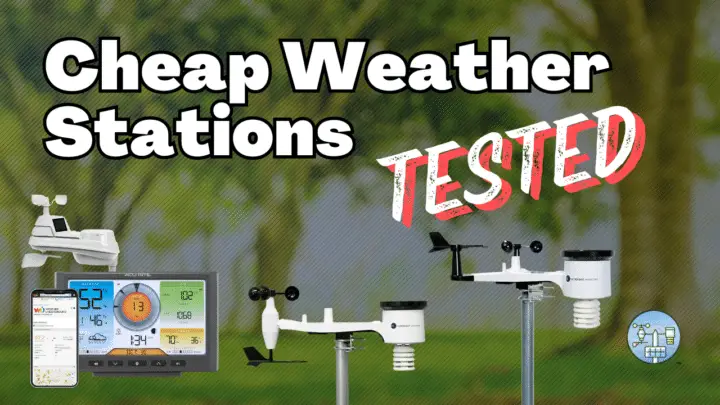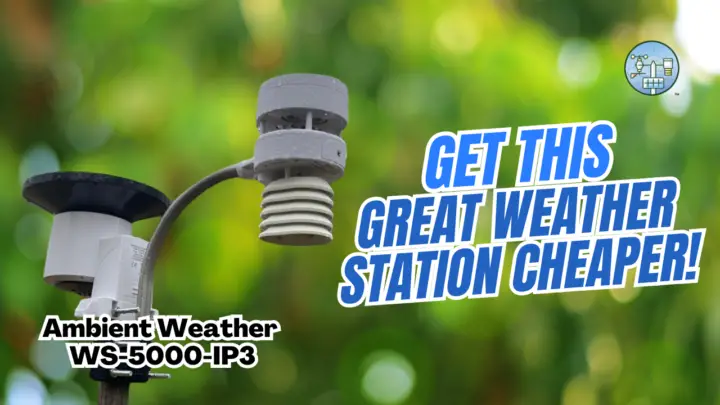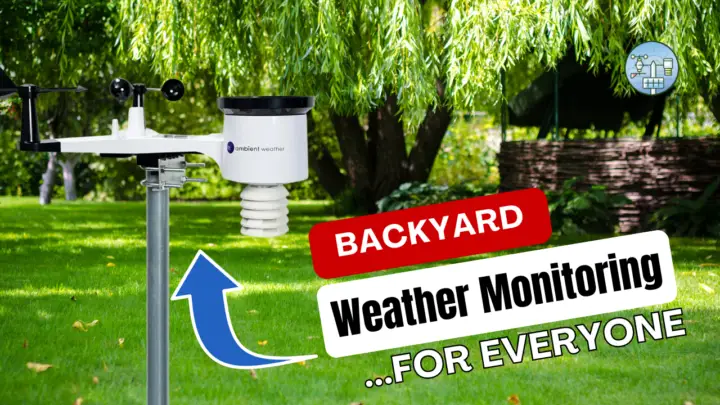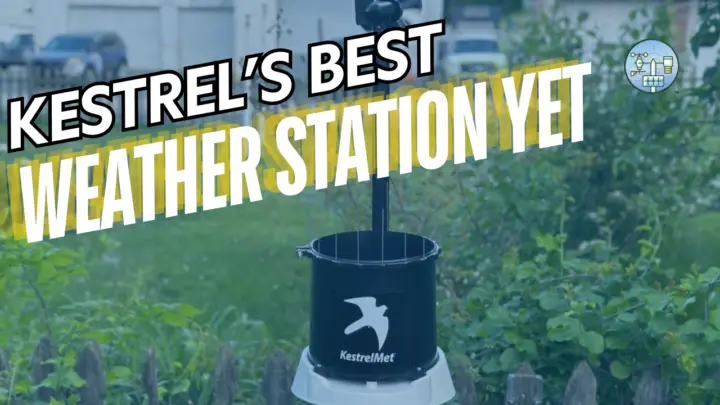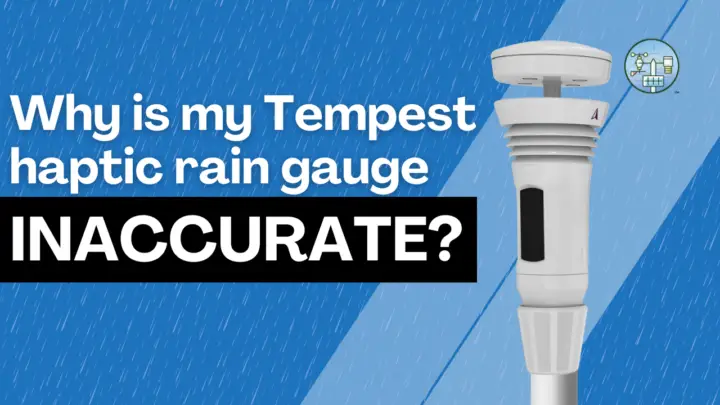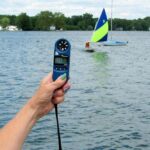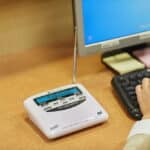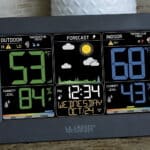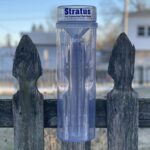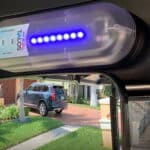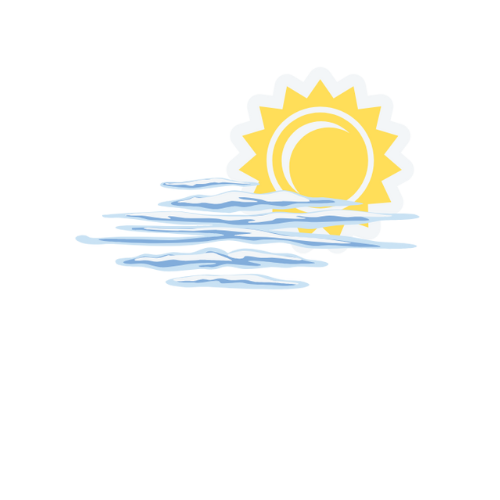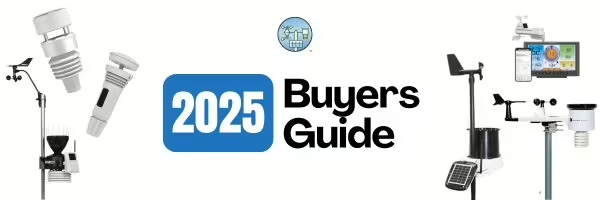
Previous years’ edition:
International weather station buyers guides:
Welcome to Our 2025 Weather Station Buyers Guide!
How to use our guide: This tab explains all the changes to this year’s ranking, and our full ratings are available on the next tab. The various manufacturer tabs provide additional information on other brands we’ve tested and recommend, along with video reviews from our library.
We’d love to hear what you think or if you have any suggestions. Leave a comment below.
So, let’s first explain what’s different about this year’s testing and ratings.
Changes to Our Weighting
Part of this has to do with changes to our weighting. We placed more weight on value in last year’s weather station buyers guide, and there was a good reason for it. Inflation was close to 10%; people were not doing well. However, the economy has proved incredibly resilient, and as people get caught back up, we’re noticing more expensive stations are again seeing interest.
But it’s a little different this time. People are choosy, and pricier stations with a lot of functionality are selling. People are also showing increasing interest in more high-tech home weather stations. Since most stations are now generally user-friendly, we are lessening the weight of that category a bit for 2025.
The video below describes our changes in more detail. We made it in whiteboard format to make it more interesting to watch.
Why are you changing the weighting?
This might seem like an effort to create drama (honestly, our list has been stale for the past few years), but I am actively trying to keep my personal biases out of these ratings, which for years were too subjective. While some scores have changed dramatically, there is a reason behind those changes, which we detail below.
Changes to Scores and Stations Recommended
We’ve made some changes to the value scores for Ambient Weather stations. We don’t have a specific category to rate support quality, but we’re aware of a definite increase in problems with WS-2902 and WS-2000 stations, often involving the sensor suite. We’ve seen an uptick in reports of customer service issues in getting support, which is a concern. As a result, these stations have lower durability scores than last year. Rolling support quality ratings into durability makes sense because both are equally important.
We are also changing our WS-5000 rating to base it on the console-less version, which debuted in the past year. Without the console, it’s a much better value, which is one of the reasons it has returned (as well as fixing a math error on our part; its score was too low!). We’re also saying goodbye to the WS-2902 and WS-2000 in favor of the WS-1553-IP, a station we admittedly missed even though it’s been out for four years!
The AcuRite Notos is being retired from our list, as it never met our basic requirements (it needs to measure temperature, humidity, wind, and rainfall). We had it in for several years because there were so few options, but that’s no longer true. It’s time for the Notos to move to the thermometers list because it is a glorified thermometer.
A caveat
Geopolitics could throw a massive wrench in our picks. The Trump administration is threatening tariffs on China, a source of parts for many home weather stations and even where some, like the Wittboy, are manufactured. Should tariffs become a reality, we’ll need to revisit our picks. 25% of the score is value, which includes price.
Below are ratings for all nine stations qualifying for our “best of” rankings. We’ve also made a video if you prefer to watch our review instead.
Since this is the second year of our 100-point system, we’re doing things differently. We’re presenting the list with their scores and the movement up or down since last year’s ratings in top-10 format (although many are new, keep that in mind). There are more solid options than ever before, so our list will reflect that. Below each, we’ll explain why each may have risen or fallen in our recommendations.
Understanding our Ratings
Each category is judged on a five-point scale:
- 5 – Superior
- 4 – Few or very minor issues
- 3 – Minor issues
- 2 – Major issues
- 1 – Deficient
The Best of the Best
1. Best Home Weather Station of 2025 – Ambient Weather WS-5000-IP3

| Accuracy (25%) | Value (25%) | Durability (20%) | Feature Set (20%) | Ease of Use (20%) | Total Score |
|---|---|---|---|---|---|
| 4.5/5 | 5/5 | 4.5/5 | 4.5/5 | 5/5 | 96/100 |
MSRP: $351.99
Find the Best DealRead Our Review
Last year’s score: N/A (New)
We typically rate all stations individually first, so we don’t calculate the final scores until then. Imagine our surprise when we realized the WS-5000 had just leapfrogged everybody! We pulled the WS-5000 from our recommendations due to its far too high price with a console that isn’t special in late 2022. However, options are now available for a console-less version, which puts the price in the same ballpark as the Tempest and no haptic rain gauge.
2. Tempest Weather System
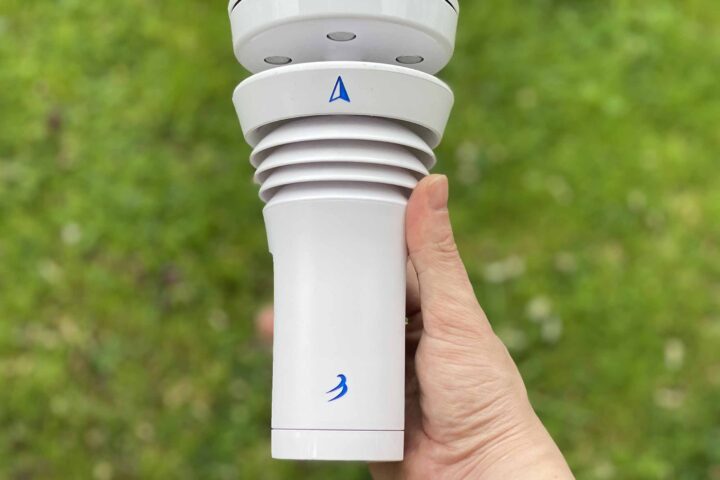
| Accuracy (25%) | Value (25%) | Durability (20%) | Feature Set (20%) | Ease of Use (20%) | Total Score |
|---|---|---|---|---|---|
| 4/5 | 5/5 | 4.5/5 | 5/5 | 5/5 | 93/100 |
MSRP: $339.00
Find the Best DealRead Our Review
Last year’s score: 95 (-2)
The Tempest has gone from a Kickstarter project to a massive home weather station network in less than a decade. It’s simple to set up and use and smart-home-ready with unparalleled lightning detection. But we can’t go without mentioning the haptic rain gauge, which, while better in our second test in 2024 versus our original test four years earlier, is still not accurate enough in light rain. But with the station out now for four years, we’re starting to get a better idea of durability, and the internal battery seems to be one of its biggest issues, eventually requiring replacement.
3. (TIE) – Best Value Home Weather Station – Ecowitt Wittboy
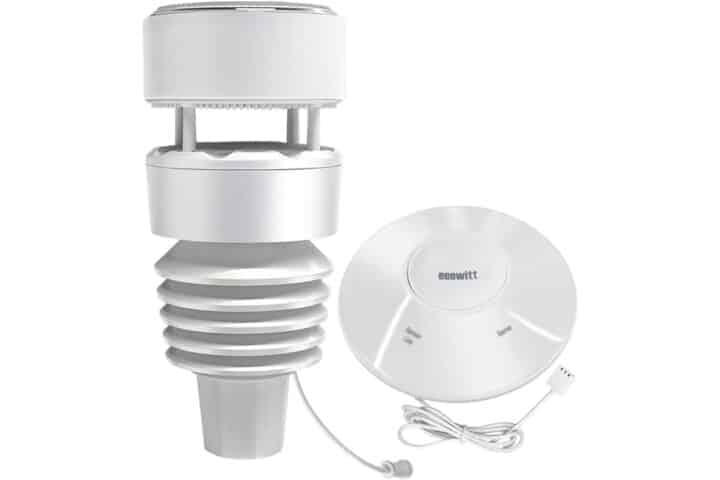
| Accuracy (25%) | Value (25%) | Durability (20%) | Feature Set (20%) | Ease of Use (20%) | Total Score |
|---|---|---|---|---|---|
| 4/5 | 5/5 | 4.5/5 | 5/5 | 5/5 | 92/100 |
MSRP: $199.99
Find the Best PriceRead Our Review
Last year’s score: N/A (New)
The Ecowitt Wittboy probably would have been on our 2024 list had I been able to get my hands on a sensor, which I couldn’t do. However, it was released quite late in 2023, so maybe not. Well, after testing the sensor, I’m impressed. While the haptic rain gauge isn’t any better than the Tempest’s, the rest of the sensors are extremely accurate. And you’re getting a sonic anemometer, which we’re big fans of for their sensitivity.
3. (TIE) Davis Vantage Pro2 Plus
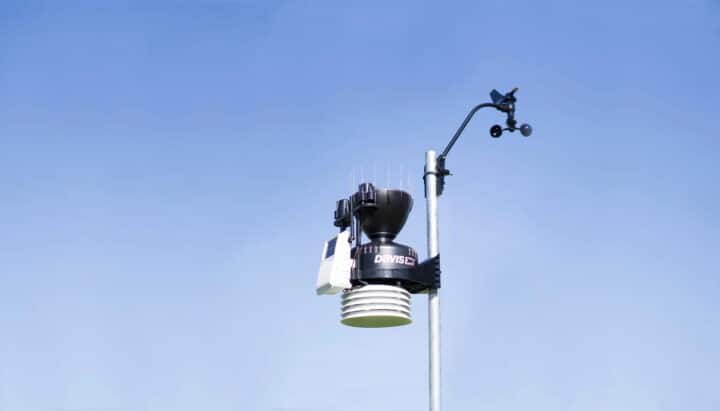
| Accuracy (25%) | Value (25%) | Durability (20%) | Feature Set (20%) | Ease of Use (20%) | Total Score |
|---|---|---|---|---|---|
| 5/5 | 4/5 | 5/5 | 4.5/5 | 4.5/5 | 92/100 |
MSRP: $1,275
Last year’s score: N/A (New – was not rated previously)
We’ll admit that we completely ignored the Vantage Pro2 Plus for years. The reason was the price. With a console that hadn’t been updated in 20 years and other pro-grade stations available, we didn’t find it a great value. With the WeatherFlow Console, that’s changed, and the Vantage Pro2 Plus is suddenly much more attractive.
I know it seems strange that we’ve added consoles here, and it made the station better when we’re suggesting you forgo them elsewhere. However, Davis stations use RF instead of Wi-Fi, so some central stations are necessary to receive data—this was standard 20 years ago when both the Vantage Vue and Pro2 were first released.
The Contenders
5. KestrelMet 6000
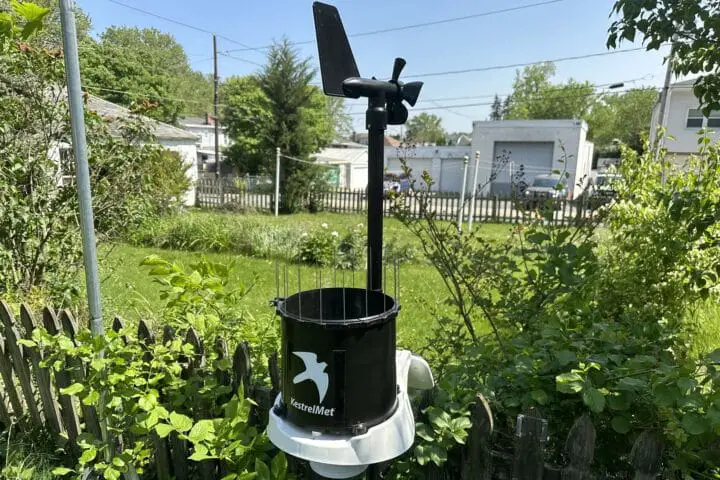
| Accuracy (25%) | Value (25%) | Durability (20%) | Feature Set (20%) | Ease of Use (20%) | Total Score |
|---|---|---|---|---|---|
| 5/5 | 4/5 | 4.5/5 | 4.5/5 | 5/5 | 91/100 |
MSRP: $999
Find the Best DealRead Our Review
Last year’s score: 95 (-4)
In our first draft of our 2025 rankings, the KestrelMet 6000 still held on to its top spot. However, over the past few months, we’ve received a few reports of reliability issues. This factored into our decision to rethink its durability rating. Not helping are the apparent customer service issues that we’ve also seen way too many times regarding Ambient Weather products (the same company that owns Kestrel). And with scores so close together among top weather stations, it made a massive difference.
6. Ambient Weather WS-1553-IP
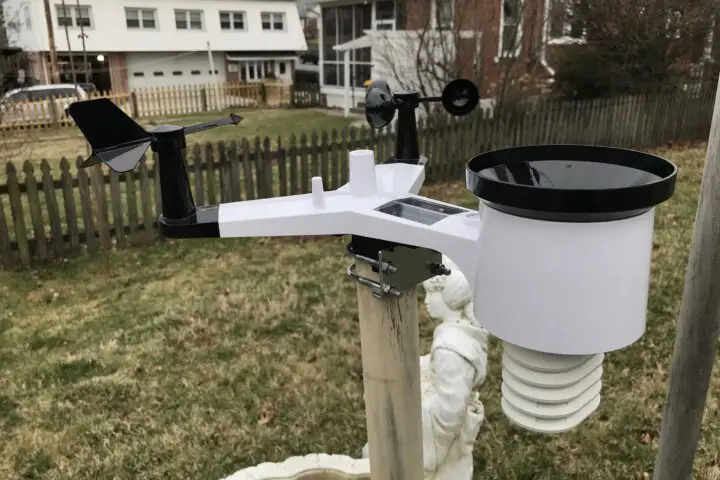
| Accuracy (25%) | Value (25%) | Durability (20%) | Feature Set (20%) | Ease of Use (20%) | Total Score |
|---|---|---|---|---|---|
| 4/5 | 5/5 | 3.5/5 | 5/5 | 5/5 | 89/100 |
MSRP: $188.99
Last year’s score: N/A (New – Replaces WS-2902 and WS-2000)
This might be the biggest example of why Ambient Weather needs to look hard at its lineup and ask themselves if so many models are necessary. We didn’t know this existed until it was bought over the Black Friday 2024 weekend. It’s been around for a half-decade, and we think this is a much better deal than buying the WS-2902 or WS-2000 since you’re getting expandability options for UNDER $200.
That said, the durability of the sensor found in these stations isn’t the best. We’re hearing an average lifespan of about 3-4 years, which is one reason why its durability score fell considerably when compared to the WS-2902 and WS-2000 that it replaced.
7. (TIE) Davis Vantage Pro2
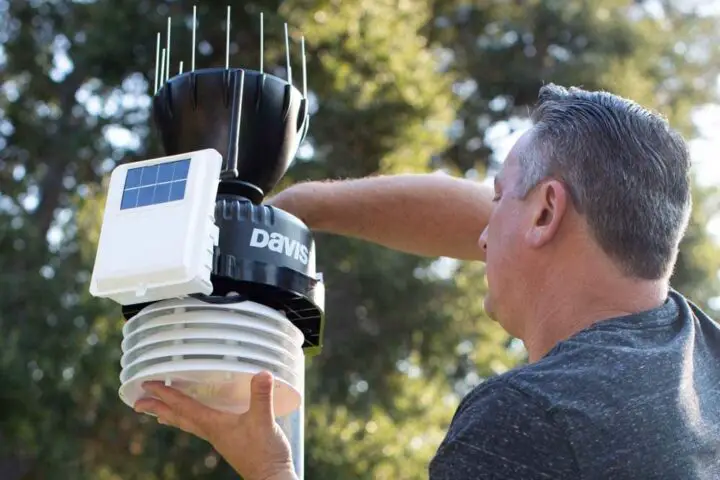
| Accuracy (25%) | Value (25%) | Durability (20%) | Feature Set (20%) | Ease of Use (20%) | Total Score |
|---|---|---|---|---|---|
| 5/5 | 3.5/5 | 5/5 | 4/5 | 4.5/5 | 88/100 |
MSRP: $995
Find the Best DealRead Our Review
Last year’s score: 87 (+1)
The King of home weather stations makes another appearance on our list for the same reasons as the Vantage Pro2 Plus. Not having fan aspiration or UV and light sensors that can be found in cheaper weather stations did hurt the VP2 in the value category. However, with market-leading durability and accuracy, the entry price is justified.
7. (TIE) Ambient Weather WS-4000
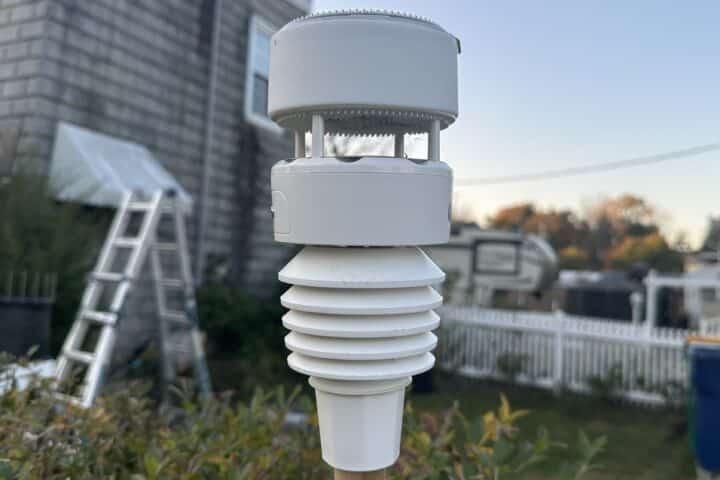
| Accuracy (25%) | Value (25%) | Durability (20%) | Feature Set (20%) | Ease of Use (20%) | Total Score |
|---|---|---|---|---|---|
| 4/5 | 4/5 | 4.5/5 | 5/5 | 5/5 | 88/100 |
MSRP: $369.99
Last year’s score: N/A (New)
Oh, Ambient Weather. I am not sure what to say here other than buy the Wittboy unless this isn’t your first Ambient Weather station. It’s disappointing to see it so much more expensive, and that is why it scores significantly lower than the Wittboy, even though it’s the same sensor- mainly because you’re forced to take the console. Without the console, the scores may have been closer. I’ve heard anecdotally that Ambient Weather has no current plans for a console-less option, which I’m trying to confirm because that makes no sense.
9. Davis Vantage Vue
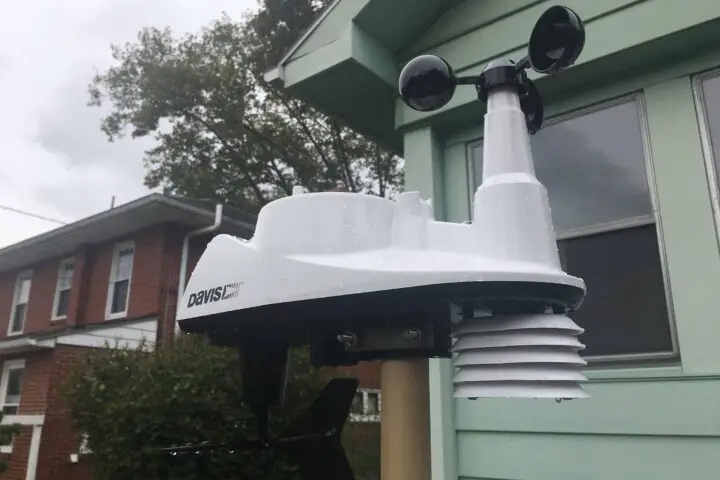
| Accuracy (25%) | Value (25%) | Durability (20%) | Feature Set (20%) | Ease of Use (20%) | Total Score |
|---|---|---|---|---|---|
| 4.5/5 | 3.5/5 | 5/5 | 4/5 | 4.5/5 | 85/100 |
MSRP: $695
Find the Best DealRead Our Review
Last year’s score: 84 (+1)
Even with the WeatherLink Console, which adds some expandability, the Davis Vantage Vue can no longer compete with the recent weather stations released by Ambient Weather and WeatherFlow. I had high hopes that the acquisition by AEM would mean some new weather station model, but that seems like it won’t happen soon. It’s a shame, I’d like to see what Davis could do with modern technology and sensors.
However, the Vantage Vue’s durability, like the Vantage Pro 2, is market-leading. While we love ours, we would have opted for the Vantage Pro2 instead if we had the money. That said, we got eight years out of our Vue before it needed its first significant overhaul, two times the lifespan of most Ambient Weather stations.
Company Profile
Founded in 1943, AcuRite is likely one of the world’s most prolific weather instrument manufacturers, with a significant retail presence for decades. Chances are you’ve seen at least one AcuRite weather station at your local retailer: Walmart, Target, and Home Depot sometimes sell the AcuRite 3-in-1 or AcuRite 5-in-1 weather stations (or both) in their brick-and-mortar stores.
Learn more about AcuRite weather stations and compare models
Our Test Results
Below are the models we have tested and recommended, along with our current scores. To learn how we figure out these scores, click here. “Best for” is the station’s best ratings in each of our five categories (4 or 5 stars), and “worst for” is the station’s lowest-rated categories (if none are under 4, then N/A will be used). Ratings and reviews are checked yearly in December and January for the following year.
* The Iris has many different configurations. Our rating is for versions with Internet access and a modern console.
Watch Our Reviews
Best AcuRite Weather Stations
AcuRite Iris Home Weather Station with Direct-to-Wi-Fi Wireless Display
This version of the AcuRite Iris home weather station is often on sale.
Among the AcuRite weather stations, the best cheap weather station is the AcuRite Iris (10544). The Iris comes in several different models, but this bundle offers a nice console with Wi-Fi connectivity and the Iris sensor suite. It's similar to the Ambient Weather WS-1900A but has a few key differences.
The AcuRite Iris does not have UV or solar radiation sensors, but it does include Wi-Fi connectivity to share your data on the internet. If you want a highly functional weather station app, we're big fans of My AcuRite. The clean UI makes navigation a breeze and chock full of information.
The Ambient Weather WS-2902 and this particular Iris model are typically competitively priced with one another, so check both to find out which one is the best deal.
If you're set on an AcuRite station, the console in this particular model is the best available, and equivalent to what you'd get with the higher end Atlas (which we generally don't recommend).
- Great display
- My AcuRite built in
- Still has the same accuracy issues
AcuRite Iris Weather Station with Large LCD Display
Larger display for easier reading from a distance
While a little more expensive that other lower-end Iris stations, this particular console is easier to read as it as as large as the HD displays offered on higher end Iris models.
- Larger display
- Still an LCD console
AcuRite Iris Wireless Weather Station with LCD Display
This often on-sale model offers internet connectivity at a low price.
One of AcuRite's lower cost Iris models, this particular model comes with a lower-end LCD display, however still supports myAcuRite for online access.
- Inexpensive
- my AcuRite is well designed
- Low-quality display
- Accuracy issues
Company Profile
Ambient Weather has had an online presence since 1998, when it started as an online shop selling various manufacturers’ weather instruments, gadgets, and accessories. In the 2010s, Ambient Weather turned to Chinese instrument maker Fine Offset to produce its branded line of weather instruments.
While station components are manufactured overseas, Ambient Weather develops its software and assembles them entirely in the United States, initially at its original Arizona headquarters and later in Boothwyn, Pennsylvania. Boothwyn is home to Nielsen Kellerman, who acquired Ambient Weather in 2019.
Learn more about Ambient Weather weather stations and compare models
Our Test Results
Below are the models we have tested and recommended, along with our current scores. To learn how we figure out these scores, click here. “Best for” is the station’s best ratings in each of our five categories (4 or 5 stars), and “worst for” is the station’s lowest-rated categories (if none are under 4, then N/A will be used). Ratings and reviews are checked yearly in December and January for the following year.
| Model | Best for | Worst for | Score (100) |
|---|---|---|---|
| WS-5000-IP3* | Value, feature set, ease of use | N/A | 96 |
| WS-1553-IP** | Value, feature set, ease of use | Durability | 89 |
| WS-4000*** | Feature set, ease of use | N/A | 88 |
| WS-1965 | Value | Ease of use | 83 |
* The WS-5000-IP3 replaces the WS-5000 in our list as a far cheaper option.
** The WS-1553-IP replaces the WS-2902 and WS-2000 in 2025, offering expandability for under $200.
*** We recommend the Ecowitt Wittboy over the WS-4000 for most applications
Watch Our Reviews
Best Ambient Weather Stations
Ambient Weather WS-5000-IP3 Home Weather Station
If you don't need a console, the WS-5000-IP3 doesn't have one, and saves you $90.
The WS-5000-IP3 features a redesigned sensor suite, including an ultrasonic anemometer. Eliminating the cup anemometer found on other weather stations drastically reduces the number of moving parts and can measure wind speed as accurately as the cup-and-vane. This should extend its useable life as the traditional anemometer requires ongoing maintenance to ensure trouble-free use.
The Ambient Weather WS-5000-IP3's sensors were much more accurate in our tests than the WS-1553-IP and WS-1965 which use slightly lower-quality sensor suites. Thanks to expandability and a wide array of optional additional sensors here, you can add just about any sensor you can think of, including air quality, soil moisture, water temperature, and lightning, all of which send data to the console in as little as every five seconds.
The company has made it easy to share your data publicly through Weather Underground. Its smart home connectivity is best in class, offering IFTTT compatibility to connect your station to your smart home system. Of course, there's Ambient Weather Network and the Ambient Weather app to view your personal weather stations' data remotely on your mobile device or through the web app.
If you're looking for a step up from cheaper Ambient Weather Stations, with accuracy that rivals any Davis station, the WS-5000-IP3 is the best home weather station.
- An impressive list of optional sensors
- Smart home connectivity
- Improved barometer and rainfall accuracy (from WS-2902 series)
- May be too much weather station for non-enthusiasts
Instead of the WS-2000 or WS-2902, save some money with this model.
This might be the biggest example of why Ambient Weather needs to take a hard look at its lineup and ask themselves if so many models are necessary. We didn’t know this existed until it was bought over the Black Friday 2024 weekend. Apparently, it’s been around for a half decade, and we think this is a much better deal than buying the WS-2902 or WS-2000 since you’re getting expandability options for UNDER $200.
That said, the durability of the sensor found in these stations isn’t the best. We’re hearing an average lifespan of about 3-4 years, which is one of the reasons why its durability score fell considerably, yet it basically stayed about the same score because the functionality’s all but the same.
- No console
- Expandability that's cheaper than the Wittboy
- Sensor suite doesn't last very long (2-3 years)
We'd recommend the Wittboy over the WS-4000 at the moment.
Oh, Ambient Weather. I am not sure what to say here other than buy the Wittboy unless this isn’t your first Ambient Weather station. It’s disappointing to see it so much more expensive and that is why it scores significantly lower than the Wittboy, even though it’s the same sensor.
- Decent accuracy
- AWN
- Too expensive
- Haptic rain gauge issues.
Company Profile
Davis Instruments started in 1969 selling sextants, a device that uses the angle between the horizon and a celestial body like the Sun, Moon, or a Star to calculate latitude and longitude. Davis’s first weather device wasn’t until 1984, the TurboMeter – a handheld wind meter for mariners. The Digital Weather Pro in 1988 was the first weather station, and WeatherLink followed in 1991, the first comprehensive weather station software available. The original Vantage Pro wouldn’t arrive until 2001 (the Vantage Pro2 launched in 2005), and the Vantage Vue in 2009.
Davis Instruments was sold to AEM after the founders’ retirement in 2019. Davis remains at its original Hayward, California headquarters, and the company has released several new devices since the acquisition, including the WeatherLink Live and WeatherLink Console, but no new weather stations.
Learn more about Davis weather stations and compare models
BIG NEWS! Through our sister site, Cirrusly Weather, we now offer Davis stations directly to you at prices better than those of Amazon. The links below will take you to the respective pages on our sister site.
Test Results
Below are the models we have tested and recommended, along with our current scores. To learn how we figure out these scores, click here. “Best for” is the station’s best ratings in each of our five categories (4 or 5 stars), and “worst for” is the station’s lowest-rated categories (if none are under 4, then N/A will be used). Ratings and reviews are checked yearly in December and January for the following year.
| Model | Best for | Worst for | Score (100) |
|---|---|---|---|
| Vantage Pro2 Plus | Accuracy, Durability | Value | 92 |
| Vantage Pro2 | Accuracy, Durability | Value | 88 |
| Vantage Vue* | Durability | N/A | 85 |
* Accuracy still rates high (4.5), but the top category is durability (5).
Watch Our Reviews
Coming soon!
Best Davis Weather Stations
With the WeatherFlow Console, the Vantage Pro2 Plus is a must-have for enthusiasts.
We’ll admit that we completely ignored the Vantage Pro2 Plus for years. The reason was the price. With a console that hadn’t been updated in 20 years, and other pro-grade stations available, we just didn’t find it a great value. With the WeatherLink Console that’s changed, and the Vantage Pro2 Plus is suddenly much more attractive.
I know it seems strange that we’ve added consoles here and it made the station better when we’re suggesting you forgo it elsewhere. However, with Davis stations, they use RF instead of Wi-Fi, so some central station is necessary to receive data — this was standard 20 years ago when both the Vantage Vue and Pro2 were first released.
- Market-leading accuracy
- Solid support
- Fan-aspiration
- Still behind in technology
- KestrelMet 6000 is better for smart home use
Davis Instruments Vantage Pro2
The Vantage Pro2 is made "new" again with the WeatherLink Console
The Davis Vantage Pro2 is one of the best high-end wireless home weather stations you can buy and is made even better by WeatherLink Live or the WeatherLink Console. The Vantage Pro2 is a proven workhorse. Several years ago in the Caribbean, a VantagePro 2 recorded a 199mph wind gust in a hurricane before its mast snapped. That's the highest wind reading ever recorded on a home weather station!
So why is the Vantage Pro2 more accurate? The sensors in the Vantage Pro2 are of higher quality than in the Vantage Vue. A larger rain gauge collects rain more efficiently, especially in windy situations. The radiation shielding around the temperature and humidity sensor is larger, allowing for better airflow.
Another difference between the VantagePro 2 and the Vantage Vue weather station is the anemometer. Since it's separate from the rest of the sensor suite, you can place it in a high location to improve your wind readings.
While it takes a bit more time to set up, no other personal weather station on the market even comes close if you want the most accurate weather data. As a side note, there is also a bundle that includes the console. While the Vantage Pro2's console is much more helpful than the Vantage Vue's, it does add to the price. Whether you need it is up to you.
Depending on the model you select, you may also have UV and Light Sensors (standard on the Pro2 Plus), and fan aspiration, which we strongly recommend if you're very concerned about accuracy. Further optional sensors include soil moisture and leaf wetness sensors, and air quality measurements via AirLink.
- The best accuracy of any home weather station
- Top-notch reliability
- Durability is impressive
- Expandability through additional sensors
- A 5-in-1 sensor isn’t the best for accurate readings
- No expandability
The WeatherLink Console makes the Davis Vantage Vue a modern weather station but also increases the price.
The Davis Vantage Vue got a much-needed update when the WeatherLink Console debuted earlier this year. It's the successor to the WeatherLink Live hub and changed how you interact with your station for the better. It's built on Android and appears to be upgradeable, so you're no longer stuck in the past with dated hardware.
The reliability of Davis weather stations is legendary in the weather enthusiast community. I've had mine running continuously since September 2016, and I know others who have had theirs for over a decade. There is also the story of a gentleman with a Davis Weather Monitor II (a predecessor to the Vue) who recently upgraded after 27 years (that's not a typo).
While you don't get the unbeatable accuracy of the high-end Davis Vantage Pro 2 home weather station, my experience has been positive. With the WeatherLink Console, sharing your data is super easy. While on your home network, you can watch live conditions (updated every two seconds), and your data is uploaded to Davis' platform once per minute.
If there's one thing I'd ding this weather station for, it's its lack of upgradeability. Sure, you get all the basics, but the only optional sensor you can add is the Davis AirLink.
- Accuracy is nearly on par with the Vantage Pro2
- Extremely reliable
- Well-constructed and durable
- The WeatherLink Console makes it even better
- A 5-in-1 sensor isn't the best for accurate readings
- You pay a premium for the name
Company Profile
Ecowitt is a wholly owned subsidiary of Shenzen Fine Offset Electronics, Ltd., a Chinese manufacturer founded in 2005. In addition to Ecowitt, Fine Offset has licensed its station designs to Ambient Weather in the United States and Froggit, Sainlogic, and other brands worldwide.
Learn more about Ecowitt weather stations and compare models
Test Results
Below are the models we have tested and recommended, along with our current scores. To learn how we figure out these scores, click here. “Best for” is the station’s best ratings in each of our five categories (4 or 5 stars), and “worst for” is the station’s lowest-rated categories (if none are under 4, then N/A will be used). Ratings and reviews are checked yearly in December and January for the following year.
| Model | Best for | Worst for | Score (100) |
|---|---|---|---|
| Wittboy | Value, feature set | N/A | 92 |
International readers: Once we can thoroughly test Ecowitt’s software, we plan to offer ratings on internationally sold Ecowitt models using our data from Ambient Weather tests later this year!
Watch Our Reviews
Best Ecowitt Weather Stations
This Tempest look-alike doesn't have all its features, but is significantly cheaper.
The Wittboy is Ecowitt's latest Wi-Fi weather station. It doesn't have lightning detection or smart home capabilities (that we can tell), but it does pretty much everything else the Tempest does.
The outdoor sensor contains a haptic rainfall sensor, light and UV sensors, an ultrasonic wind speed sensor, and temperature and humidity sensors. Ecowitt also includes its Wi-Fi hub, which allows you to send your data to Weather Underground.
- Decent accuracy
- DIYer-friendly
- Local storage
- Haptic rain gauge is no better
Company Profile
Nielsen Kellerman founders and lead engineers Richard Kellerman and Paul Nielsen designed the Kestrel weather meter in the 1990s and, during their research, developed four patented measurement technologies for it that are still used today. The first commercially available products arrived in 1996.
Nielsen Kellerman also owns two other high-profile weather brands, Ambient Weather, which it acquired in 2019, and pro-grade weather station manufacturer Rainwise, which it acquired the following year. Nielsen Kellerman assembles all Kestrel weather meters at its factory in Boothwyn, Pennsylvania, just outside Philadelphia.
Learn more about Kestrel weather stations and meters and compare models
Test Results
Below are the models we have tested and recommended, along with our current scores. To learn how we figure out these scores, click here. “Best for” is the station’s best ratings in each of our five categories (4 or 5 stars), and “worst for” is the station’s lowest-rated categories (if none are under 4, then N/A will be used). Ratings and reviews are checked yearly in December and January for the following year.
| Model | Best for | Worst for | Score (100) |
|---|---|---|---|
| KestrelMet 6000 | Accuracy, ease of use | N/A | 91 |
Watch Our Reviews
Best Kestrel Weather Stations
The KestrelMet 6000 is pricey and not for everybody. But hardcore weather enthusiasts will find a lot to love.
At $999, the KestrelMet 6000 home weather station is not for the casual weather enthusiast. Despite this, its excellent features, such as top-tier accuracy, ease of installation, and high-quality construction, make it a worthwhile investment for hardcore weather fans.
Standard are indoor and two outdoor sensors for temperature and relative humidity, measurements, rainfall, wind speed and direction, and barometric pressure. Solar irradiance sensors and soil moisture and leaf wetness sensors are available as an option at the time of purchase. While the hefty price tag may be daunting, for those who value accuracy and the capacity for expansion, the KestrelMet 6000 is a solid choice.
We’ve received a few reports of reliability issues. This factored in our decision to rethink its durability rating, which is why it is no longer an Editor's Choice. Not helping is the apparent customer service issues that we’ve also seen way too many of regarding Ambient Weather products (Kestrel is owned by the same company). And with scores so close together among top weather stations, it made a massive difference.
- Installation is easy
- Top-tier accuracy
- The app and web portal are easy to use
- High-quality construction
- High price (although a good value)
- Customer service issues
Company Profile
La Crosse was founded in 1983 by its owner and current president, Allen McCormick, who traveled nationally with his mobile showroom of products. The company’s first devices were clocks, but the company has since expanded internationally with weather data, atomic time, and other home devices. The company’s main headquarters, sales, and distribution remain in La Crosse, Wisconsin, the company’s namesake.
Two interesting facts about La Crosse: it was the first to introduce radio-controlled clocks to the US market (1991) and sold the first internet-connected weather station in 2008.
Learn more about La Crosse weather stations and compare models
Test Results
Coming soon. No stations from this manufacturer have been thoroughly tested using our current protocols.
Watch Our Reviews
Popular La Crosse Weather Stations
La Crosse Technology C85845-INT Weather Station, Black
This Amazon bestseller is our top pick in indoor outdoor thermometers.
While we generally don’t recommend La Crosse weather stations as there are better options, one thing La Crosse Technology does well is indoor and outdoor thermometers. One of the best indoor-outdoor thermometers is the C85845-INT, which features an adjustable brightness color display and an attractive console that doesn’t take up much space and the temperature is readable from a considerable distance.
In addition to indoor and outdoor temperature and humidity, this large display indoor outdoor thermometer also measures the dewpoint and heat index, and “comfort levels” are shown below the humidity readings. While the C85845-INT does measure barometric pressure to provide a forecast, that information isn’t shown.
The console runs off AC power, with 3 AA batteries as backup (the outdoor sensor also requires batteries). La Crosse also sells a radiation shield for the sensor to improve the accuracy of outdoor temperature measurements, which we recommend.
- Large, bright display
- Battery backup
- Accuracy isn't great without optional radiation shield for the outdoor sensor
La Crosse 308-1414MB-INT Weather Station with Mold Indicator
If you have a mold problem, the La Crosse 308-1414MB-INT is a good choice.
If you live in a damp home, you're probably all too familiar with mold. It thrives in cool and humid environments, so it's crucial to monitor the temperature and humidity in spots in your home where mold is most likely to grow. The La Crosse 308-1414MB-INT monitors these conditions and will sound an alert if it believes there is a high risk of mold growth.
Otherwise, the feature set is similar to the C85845-INT, our top pick. If you don't have mold issues, that might be the better option (the good news is they're often priced about the same on Amazon if you don't know which one to choose!).
- Helps with mold issues
- Not any better than the C85845
La Crosse Technology V42-PRO-INT Professional Weather Center with Combo Sensor and Remote Monitoring
If on sale, it's worth it to consider this station.
The La Crosse V42A-PRO-INT is a fully-featured weather station, unlike the C85845-INT. In addition to indoor and outdoor temperature and humidity, the V42A-PRO-INT measures wind speed, wind direction, and rainfall. It's expandable using other La Crosse sensors and can connect to Wi-Fi. It also has forecast icons that change with the seasons, which we've always found to be a cool feature of the company's weather stations.
We'd recommend the Ambient Weather WS-2902 or WS-1553-IP at this price if it's cheaper. But occasionally, this model is on sale for a substantial discount, making it an attractive option for those on a budget.
- Fully featured weather station
- App isn't the greatest
Company Profile
Maximum Weather Instruments is a Natick, Massachusetts-based “heirloom quality” analog and digital weather instrumentation manufacturer. Founder Gordon White developed the first Maximum instrument, an anemometer capable of capturing the “maximum” wind gust in his Dover home. He expanded a wide variety of weather instruments, all hand-crafted using similar techniques in use since Gordon White’s anemometers.
Maximum’s product lineup is relatively complex, so we suggest you check out our guide to help you decide.
Test Results
Coming soon. No stations from this manufacturer have been thoroughly tested using our current protocols.
Our Favorites from the Line
Maximum Criterion Thermometer - Brass Case, Silver Face
Maximum's Criterion isn't only beautiful to look at, but extremely accurate, too.
While the Criterion is an expensive indoor-outdoor thermometer, we wholeheartedly recommend it thanks to its high-quality construction and outstanding accuracy. Maximum Weather Instruments, a Massachusetts company, assembles these instruments by hand and tests every instrument before they go out the door.
You can monitor the temperature in up to three locations, with an adjustable marker to mark the current temperature to watch for trends. The Criterion is a great first Maximum instrument, and once you see how good it looks (and works), we think it won’t be your last.
- High quality construction
- Accuracy that's tested before it leaves the factory
- It's an investment, for sure
Maximum Mini-Max Remote Reading Thermometer - Brass Case, Silver Dial
- Electronic memory stores high and low readings until manually reset
- Readings in Fahrenheit and Celsius, with temperature minder to mark the current temperature
- AC adapter and outdoor temperature sensor with 60' cable included
- Electronic memory stores high and low readings until manually reset
- Readings in Fahrenheit and Celsius, with temperature minder to mark the current temperature
- AC adapter and outdoor temperature sensor with 60' cable included
Maximum Maestro Wind Speed and Direction
- Maestro displays wind speed, wind direction and the highest gust (up to 100 MPH and 160 km/h)
- A self-powered rooftop sensor measures the wind speed.
- The wind direction is displayed across 16 compass points using LEDs that run off the supplied AC power pack
- Leverage Maximum’s unique Gust Register to save the highest gust, which also allows you to monitor highest gusts even when you missed the actual wind blast
- Maestro ships complete with 60' cables, AC adapter, sensors and mounting hardware
- Maestro displays wind speed, wind direction and the highest gust (up to 100 MPH and 160 km/h)
- A self-powered rooftop sensor measures the wind speed.
- The wind direction is displayed across 16 compass points using LEDs that run off the supplied AC power pack
- Leverage Maximum’s unique Gust Register to save the highest gust, which also allows you to monitor highest gusts even when you missed the actual wind blast
- Maestro ships complete with 60' cables, AC adapter, sensors and mounting hardware
Company Profile
Tempest began as a Kickstarter project of WeatherFlow Networks, a worldwide private weather observation network best known for its coastal weather station network, which is often cited during landfalling tropical systems. The first WeatherFlow Tempest debuted in 2020, with the company spinning off into a separate entity and renaming the product the Tempest Weather System in 2023.
Test Results
Below are the models we have tested and recommended, along with our current scores. To learn how we figure out these scores, click here. “Best for” is the station’s best ratings in each of our five categories (4 or 5 stars), and “worst for” is the station’s lowest-rated categories (if none are under 4, then N/A will be used). Ratings and reviews are checked yearly in December and January for the following year.
| Model | Best for | Worst for | Score (100) |
|---|---|---|---|
| Tempest | Value, feature set, ease of use | N/A | 93 |
Watch Our Reviews
The WeatherFlow is still a great option, although a shorter lifespan than other stations in its price range.
WeatherFlow is a relatively recent entrant to the home weather station market, although it has years of experience. Its coastal network of professional weather stations has been delivering vital information to meteorologists for years and has proven useful (and durable) in landfalling hurricanes.
The Tempest Weather System is WeatherFlow's first attempt at a wireless home weather station. For the most part, it's a good start. It's the only one of our stations with built-in lightning detection, one of Tempest's standout features, and operates entirely on solar power.
We found that the real-time lightning data matched better with historical data than from professional lightning detection networks. It regularly detected distant lightning faster than any other station we've tested. In addition to lightning data, the Tempest measures indoor and outdoor temperature and humidity, barometric pressure, and UV and light intensity.
Wind is measured by a sonic anemometer which we found to be fairly accurate. And up until the Ecowitt Wittboy, the Tempest Weather System was the only home weather station to use a haptic rain sensor.
See our review for a way to save 10% off your next purchase from WeatherFlow.
- Super quick setup
- Outstanding lightning detection
- Fairly accurate instrumentation
- Ready for the smart home
- The haptic rain sensor doesn’t measure rainfall accurately enough
- No expandability
Logos shown here are for illustration purposes and are trademarks of their respective brands.
About Our Reviews
We have experience with all the products and companies we recommend here on TWSE. Our review staff includes degreed meteorologists and scientists, some of whom have owned the products they review for several years. Our staff has reviewed home weather gadgets for over a decade on TWSE and elsewhere.

